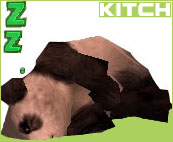Meta Life
I spend quite a good deal of my social and recreational time in the meta. I consider myself an avid supporter and pioneer of all things meta.
All meta-living means is that your support an identity and lifestyle that exists mainly in the virtual realm. This could be related to a massively multi-player role playing game like World of Warcraft and/or the ever growing number of life caching applications out there such as Twitter, Seesmic, and Facebook. Life caching is the act of micro-uploading pieces of your personal life online as it unfolds. This usually involves things like using applications such as Twitter, a micro blogging tool that allows you 140 lines of text to share what you're doing or thinking at any point in the day. For example, you can twitter that you just arrived at work or that you just spilled coffee all over your keyboard.
Thanks to smart phones, you can also upload pictures related to the current moment of your life and upload it in real time to share with your network of friends through applications like Twitpic. In these ways, you stay connected to the meta even though you might not be at your computer or in the application you use to converse with other metazens.
Connectivity is one of the key tools in pioneering the expansion of the metaverse. It is symbolic of the fact that when we engage in the meta, we're not just a person and a screen or a person and a search engine or a person and a game. We are people existing in a dynamic society that exists and thrives almost solely in the virtual realm. The communities that form through the meta are strong because they are not based on physical connection but emotional, intellectual, and commonality. Having access to 24/7 communication among communities makes them extremely strong and lasting.
Communication and connection is also one of the keystones of the metaverse. Expanding how we communicate online and how engage one another as metazens help the growth of meta societies. Because the metaverse poses very little physical or societal prejudices, our identities become more solidified in the meta. Our meta selves hit the core of who we are. We get to project freely what we want to about ourselves.
Currently, the context of the meta is limited to 2-D text and pictures but applications like Second Life and World of Warcraft are pushing the boundaries of how we engage one another online. Second Life allows users to create avatars of themselves and interact with other users in a 3-D world mostly on a commercial basis. Virtual property and virtual goods now actually have real world value. You exist once again in a simulated world and interact with people much like you do in the RL (real world). The difference? Flexibility of self and opportunity to expand your social network.
We're all aware of the limitations of how we engage in the real world. The opportunities to form communities and spend vast amounts of time engaging in real life society just doesn't work for the average person anymore. People work long day jobs, most have children or families, and not many have the income to spend going out every night. The meta allows you to plop down on your computer chair in your pajamas and socialize with two or one hundred people at a time! Your social life can begin at 10pm easily in the metaverse.
You have the flexibility to project whatever lifestyle you want to engage at your own discretion. Today, I'm an avid knitter chatting to my knitting friends, tomorrow I'm an entrepreneur who is going to try and sell $100,000 worth of virtual property, and the next day I'm off to listen to some guy in Brazil spin some records all night.
The beauty about meta life is that it is nowhere near defined. We keep pushing the ideas and tools of connectivity every day.
